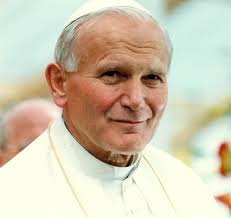 John Paul II (Latin: Ioannes Paulus II; Italian: Giovanni Paolo II; Polish: Jan Paweł II), born Karol Józef Wojtyła on 18 May 1920, served as Pope from 1978 to 2005. He is referred to by Catholics as St John Paul the Great, especially in naming institutions.
John Paul II (Latin: Ioannes Paulus II; Italian: Giovanni Paolo II; Polish: Jan Paweł II), born Karol Józef Wojtyła on 18 May 1920, served as Pope from 1978 to 2005. He is referred to by Catholics as St John Paul the Great, especially in naming institutions.
He was elected by the second Papal conclave of 1978, which was called after Pope John Paul I, who was elected in August after the death of Pope Paul VI, died after thirty-three days. Cardinal Wojtyła was elected on the third day of the conclave and adopted his predecessor’s name in tribute to him. In the years since his death on 2 Apr 2005, John Paul II has been canonised as a saint by the Catholic Church.
John Paul II is recognised as helping to end Communist rule in his native Poland and eventually all of Europe. John Paul II significantly improved the Catholic Church’s relations with Judaism, Islam, the Eastern Orthodox Church, and the Anglican Communion. He upheld the Church’s teachings on such matters as artificial contraception and the ordination of women, but also supported the Church’s Second Vatican Council and its reforms.
He was one of the most travelled world leaders in history, visiting 129 countries during his pontificate. As part of his special emphasis on the universal call to holiness, he beatified 1,340 people and canonised 483 saints, more than the combined tally of his predecessors during the preceding five centuries. By the time of his death, he had named most of the College of Cardinals, consecrated or co-consecrated a large number of the world’s bishops, and ordained many priests. A key goal of his papacy was to transform and reposition the Catholic Church. His wish was “to place his Church at the heart of a new religious alliance that would bring together Jews, Muslims and Christians in a great religious armada.”
He was the second longest-serving pope in modern history after Pope Pius IX, who served for nearly 32 years from 1846 to 1878. Born in Poland, John Paul II was the first non-Italian pope since the Dutch Pope Adrian VI, who served from 1522 to 1523. John Paul II’s cause for canonisation commenced in 2005 one month after his death with the traditional five-year waiting period waived. On 19 December 2009, John Paul II was proclaimed Venerable by his successor Pope Benedict XVI and was beatified on 1 May 2011 (Divine Mercy Sunday) after the Congregation for the Causes of Saints attributed one miracle to his intercession, the healing of a French nun from Parkinson’s disease. A second miracle attributed to John Paul II’s intercession was approved on 2 July 2013, and confirmed by Pope Francis two days later (two miracles must be attributed to a person’s intercession to be declared a saint). John Paul II was canonised on 27 April 2014 (again Divine Mercy Sunday), together with Pope John XXIII. On 11 September 2014, Pope Francis added John Paul II’s optional memorial feast day to the worldwide General Roman Calendar of saints, in response to worldwide requests. It is traditional to celebrate saints’ feast days on the anniversary of their deaths, but that of John Paul II (22 October) is celebrated on the anniversary of his papal inauguration. – Catholic Online
 Timothy Giaccardo was born in Narzole (Piedmont), Italy, on 13 June 1896. As a boy, he met Fr James Alberione and entered the seminary of Alba. Sensitive to the needs of the times and open to the new instruments of evangelisation, in 1917 he transferred, with the consent of his bishop, from the seminary of Alba to the newly-born Society of St. Paul. He was the first Pauline priest. In January 1926, he was sent to Rome to initiate the Congregation’s first branch house. In 1936, he returned to Alba to fill the position of superior of the Motherhouse. Vicar General of the Society of St Paul, faithful collaborator of the Founder, he tirelessly worked on behalf of the Pauline congregations, assisting in their birth and spiritual/apostolic development. Offering his life in order that the Congregation of the Pious Disciples of the Divine Master might receive official recognition by the Church, he died in Rome on 24 January 1948. He was proclaimed “Blessed” on 22 October 1989. – paoline.org
Timothy Giaccardo was born in Narzole (Piedmont), Italy, on 13 June 1896. As a boy, he met Fr James Alberione and entered the seminary of Alba. Sensitive to the needs of the times and open to the new instruments of evangelisation, in 1917 he transferred, with the consent of his bishop, from the seminary of Alba to the newly-born Society of St. Paul. He was the first Pauline priest. In January 1926, he was sent to Rome to initiate the Congregation’s first branch house. In 1936, he returned to Alba to fill the position of superior of the Motherhouse. Vicar General of the Society of St Paul, faithful collaborator of the Founder, he tirelessly worked on behalf of the Pauline congregations, assisting in their birth and spiritual/apostolic development. Offering his life in order that the Congregation of the Pious Disciples of the Divine Master might receive official recognition by the Church, he died in Rome on 24 January 1948. He was proclaimed “Blessed” on 22 October 1989. – paoline.org
